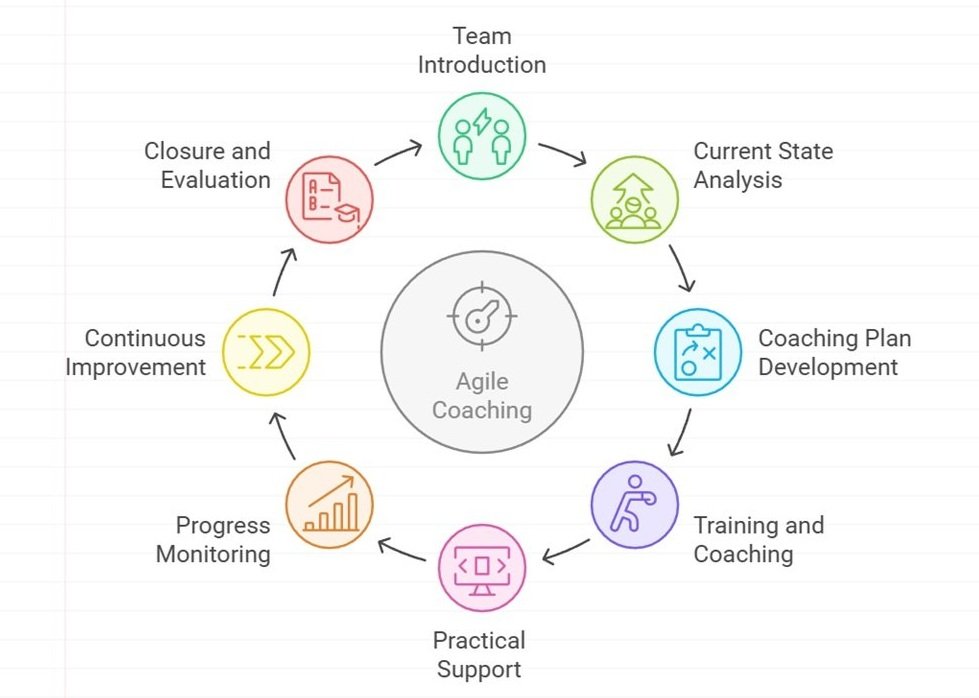Agility in business operations: help with coaching
Companies have not yet fully embraced coaching as a way to help increase agility in business operations. Coaching is seen as intangible and difficult to measure, and it’s not fully recognized as a great way to increase agility. Professional agile coaching can help companies on their journey to become an agile company.
What is the difference between mentoring and coaching?
Coaching and mentoring often get mixed up as concepts. There are distinct differences between the two, even though both aim to help and support individuals’ development. Mentoring is more about sharing knowledge on a long-term basis, whereas coaching is focused on shorter-term, result-oriented development.
Mentoring
Focus: Long-term personal and professional development.
Relationship: Usually ongoing and based on the guidance of a more experienced person.
Approach: More informal, emphasizing advice and sharing experiences.
Goal: To help the mentee grow more broadly in their career and life.
Coaching
Focus: Improving specific skills, performance, and goals.
Relationship: Shorter-term, focus on achieving specific tasks and goals.
Approach: More structured, the coach asks questions and gives feedback to help the individuals find their own solutions.
Goal: To improve an individual's performance or behavior through measurable goals.
As a concept, coaching is perhaps more known in the world of sports. Luckily though, it is utilized more and more in the business context, to help companies operate in an agile way. Coaching is always a process with defined steps and milestones, as well as measurable goals. A knowledgeable Agile Coach can utilize coaching to help in agile development in a flexible and engaging way, with the purpose of supporting individuals and teams to adopt agile methods and improve their performance.
The stages of the agile coaching process
The agile coaching process can have the following steps:
1. Team Introduction
The goals of coaching are defined.
Actions: Meeting to hear expectations, the team's current situation, and hopes for the future.
2. Current State Analysis
Current processes, systems, and team dynamics are analyzed.
Actions: The team's current working methods and possible challenges are analyzed.
3. Coaching Plan Development
A concrete plan is developed to achieve the goals.
Actions: Clear, measurable goals are defined, and suitable tools and methods are selected.
4. Training and Coaching
The necessary knowledge and skills to adopt agile methods are provided.
Actions: Trainings, workshops, and practical exercises are organized.
5. Practical Support
The team is supported in their daily work and helped to apply the learned methods.
Actions: Participation in sprint planning, retrospectives and daily meetings.
6. Progress Monitoring
The team's progress is constantly evaluated and the necessary changes are made.
Actions: Measures such as velocity, cycle time, and lead time are used (think of suitable measures together — measures cannot be copied directly), and the team's feedback is collected.
7. Continuous Improvement
The team’s continuous development is ensured, and its working methods are constantly improved.
Actions: Regular retrospectives are organized and action plans are updated based on new learnings.
8. Closure and Evaluation
The impact of coaching is evaluated and it is ensured that the team is ready to work independently.
Actions: A final meeting is held, final feedback is collected and lessons learned are documented.
Agile processes require commitment from the entire company
Just like any other skill, the renewal process of business operations requires many repetitions. There are no quick wins, and the agile process affects the whole company. The IT development process can't be renewed if the company’s top management doesn’t buy into agile methodologies. Agility deals with everything and everyone. If all stakeholders are engaged, it is a well-suited development method for the whole company. The agile process changes operations, it’s a change that affects people differently. This is why an Agile Coach can help with the transition towards an agile company.

